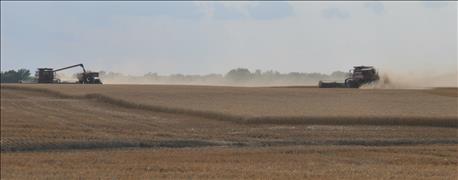
Zach Shaw has been custom cutting wheat for 11 years. What he saw Monday in Lane County was something he's never seen before.
As he rolled through a lush, golden field on Vance Ehmke's farm he was suddenly struck by what he saw on the combine yield monitor: numbers that never dropped below 100.
"At first it didn't register," he said. "Then I realized I'd gone about an eighth of a mile and I was watching the monitor move somewhere between 100 and 145, but never below 100. I grabbed my phone and made a video."
Shaw, who works with Tercel Trucking and Harvesting said the best yield he had seen before Monday was an irrigated field in southern Nebraska.
"That field made 139 bushels," he said. "That's a great yield but it was irrigated wheat. Never, ever have I seen dryland wheat like this."
Ehmke said the variety was KanMark, a Kansas Wheat Alliance release from two years that was developed by Kansas State University breeder Alan Fritz.
But, he said, KanMark is not the only field that has been exceptional.
"We had a half-section of Brawl that ha peaks of 145 bushels," he said. "The low spots in that field were around 60, which is still really good wheat. Brawl is a Clearfield variety released by Colorado State University through the Colorado Wheat Research Foundation.
Ehmke said he has still to cut a field of Byrd, which he thinks will be his best and he had heard that the K-State White Wheat variety, Joe, developed at Fort Hays State University and named for long-time breeder there, Joe Martin, made 100 to 110 bushels in variety trials this year.
"I've heard that Oakley is extremely good, too," he said. "This has just been an incredible year, a once-in-a-lifetime year. We had the combination of just perfect weather conditions. I guess all we've really needed to grow really high-yielding wheat is English weather."
Ehmke said he considers himself "just as smart today as I was three years when I was cutting 25-bushel wheat." The difference is not what he did, but what Mother Nature provided, he added.
Beyond the great yields -- especially appreciated in a year when prices are not so great -- Ehmke said he is delighted to finally have heavy stubble to protect his fields from the hot sun after harvest and to provide a thick residue for protection for wind erosion.
"This kind of residue is going to be beneficial for years to come," he said.
About the Author(s)
You May Also Like






